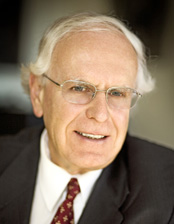Lehigh University
Office or Center Name Here
Zdenĕk P. Bažant
McCormick Institute Professor & Walter P. Murphy Professor
Northwestern University, Evanston
Progress Engendered by Collapses of Record Setting Structures: Malpasset Dam, World Trade Center Towers and KB Bridge in Palau
click here to view video
Friday, February 26, 2010
4:10 P.M..
Sinclair Laboratory Auditorium
Overview:
When built, these were the tallest and slenderest arch dam, the tallest building, and the prestressed box girder of world-record span. The mechanisms of collapse of these structures are clarified. The size effect is shown to have been an important factor in the 1959 failure of the Malpasset Dam. Second, the disputed causes of the twin WTC towers collapse in New York on 9/11/01 are discussed. Third, the 1996 collapse of the Koror-Babeldaob prestress concrete box girder in Palau, with a 241 m span, is analyzed. The lessons from these regrettable catastrophes are bound to advance the structural engineering profession.
ZDENĔK P. BAŽANT: Born and educated in Prague (Ph.D. 1963), Bažant joined Northwestern in 1969, where he has been Walter P. Murphy Professor since 1990 and simultaneously McCormick Institute Professor since 2002, and Director of Center for Geomaterials during1981-87.
He was inducted to National Academy of Sciences, National Academy of Engrg.and Am. Acad. of Arts & Sciences., as well as Italian Nat. Acad. (dei Lincei), Austrian Acad. of Sciences, Czech Acad. of Engrg., Spanish Royal Acad. of Eng., Eur. Acad. of Sci. & Arts, and Istituto Lombardo. An ASCE Hon. Member and Illinois Registered Structural Engineer, he received six honorary doctorates (Prague, Karlsruhe, Colorado, Milan, Lyon, Vienna); ASME Timoshenko, Nadai and Warner Medals; ASCE von Karman, Newmark, Croes Medals, Honorary Membership and Lifetime Achievement Award; SES Prager Medal; RILEM L'Hermite Medal; Torroja Medal in Spain; etc.
He authored six books: Scaling of Structural Strength, Inelastic Analysis, Fracture and Size Effect, Stability of Structures, Concrete at High Temperatures, and Concrete Creep. With the H-index of 44 and >10,600 citations, he is one of top 100 ISI Highly Cited Scientists in Engrg.
Progress Engendered by Collapses of Record Setting Structures: Malpasset Dam, World Trade Center Towers and KB Bridge in Palau:
When built, these were the tallest and slenderest arch dam, the tallest building, and the prestressed box girder of world-record span. The mechanisms of collapse of these structures are clarified. The size effect is shown to have been an important factor in the 1959 failure of the Malpasset Dam. Although indisputably the immediate cause of failure was the movement of abutment, the size effect must have caused that the tolerable foundation movement was only about 25% of that predicted in design by the classical analysis based on constant material strength. Second, the disputed causes of the twin WTC towers collapse in New York on 9/11/01 are discussed. It is shown that gravity driven progressive collapse, triggered by creep buckling of heated columns and attenuated by mass accretion, comminution of concrete slabs and ejection of air, matches all the observations. Third, the 1996 collapse of the Koror-Babeldaob prestress concrete box girder in Palau, with a 241 m span, is analyzed. The collapse occurred 3 months after questionable remedial prestressing, undertaken because the bridge deflected by 1.61 m (compared to the design camber), instead of 0.3 m expected in design. While the current empirical ACI and fib creep and shrinkage models agree with the design calculations, a 3D step-by-step creep analysis with the theoretically founded model B3 developed at Northwestern is shown capable of explaining the observed 18-year deflections as well as the prestress loss in grouted tendons whose value, measured before retrofit, was surprisingly large (49% in the mean). Since the girder was 14.2 m deep at the piers, the size effect was likely one factor in this spectacular failure, whose mode was seen to be the shear-compression fracture of the webs. Some other shear failures of RC structures in which the size effect was a likely a factor are briefly pointed out. The lessons from these regrettable catastrophes are bound to advance the structural engineering profession.
The Fazlur R. Khan Distinguished Lecture Series has been initiated and organized by Dan M. Frangopol, the first holder of Lehigh's Fazlur Rahman Khan Endowed Chair of Structural Engineering and Architecture.
